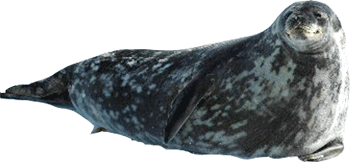Weddell Seal

Scientific Classification
- Kingdom: Animalia
- Phylum: Chordata
- Class: Mammalia
- Order: Carnivora
- Family: Phocidae
- Genus: Leptonychotes
- Species: weddellii
Description
Weddell seals are dark gray with darker and lighter spots. They can be 1,200 pounds in weight and 10 feet in length. Weddell seals can be heard from on top of the ice. Weddell seals do not travel very far and will often be found within a few miles of where they were born.
Size
Adult males and females are about 3 m long and weigh around 400 to 500 kg.
Diet
Weddell seals are carnivores. Their food varies with occasion and location but mid-water (pelagic) and bottom dwelling (benthic) fish, squid, octopus and prawns are common.
Breeding
Weddell seals haul-out onto the steady fast-ice to rest and moult, and for females to pup, recurring to the same area each year. Females of six years and over provide birth in October to one pup per year. Pups weigh 25-30 kg at birth and mothers care for them for six weeks by which time they contain grown to 110-140 kg. Pups learn to swim and haul-out of the water from one week old.
Abundance and Distribution
Weddell seals have a circumpolar distribution and are coastal, staying around the fast ice and venturing only 15 to 20 km into the Southern Ocean to feed. Weddell seals haul-out onto the fast-ice to rest and moult, and for females to pup.
Weddell seals are very placid sedentary animals. They can be approached without much apparent pressure to the animal. When they haul-out they remain close to their access hole on top of the ice. Underwater they remain comparatively close to their breeding colonies, usually within 50-100 km though occasional migrations of several hundred kilometres do occur, particularly by juveniles.
Weddell seals are the most southerly ranging mammal to enduringly inhabit the continent. Sightings of the seals have been made in New Zealand and Australia, though they are very rare indeed.
 Deep Sea Crabs
Deep Sea Crabs